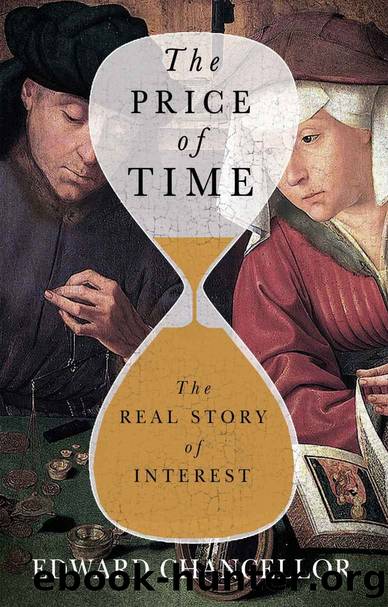The Price of Time by Edward Chancellor

Author:Edward Chancellor [Chancellor, Edward]
Language: eng
Format: azw3, epub
ISBN: 9780802160072
Publisher: Grove Atlantic
Published: 2022-08-16T00:00:00+00:00
THE CURSE OF NEGATIVE RATES
Between the world wars a number of monetary cranks appeared, each offering his own idiosyncratic cure for economic maladies. In the 1920s, a former British Army major, C. H. Douglas, proposed interest-free âsocial creditsâ to boost demand in Britainâs moribund economy.fn10 Another Englishman, Frederick Soddy, whose thoughts on virtual wealth we have already encountered, proposed a new paper currency whose issuance would be based on the mathematical model used by the tote board at Sydneyâs racecourse. Less attractive was the demagogue Radio Priest, Father Coughlin, who in the 1930s called for the nationalization of the Federal Reserve and for silver money to be issued in unlimited quantities.19
Among the economic heretics of this era was a German-born businessman named Silvio Gesell. Gesell had been employed as a merchant in Buenos Aires in the early 1890s, where he witnessed Argentinaâs great financial crisis. In Gesellâs view, the subsequent economic downturn had been exacerbated by the hoarding of money. He came up with an original solution to this problem. To boost the circulation of money during depressions, Gesell proposed a law requiring that banknotes be stamped every week. The annual cost of the stamps was to be set at 5 per cent of the notesâ face value. Under Gesellâs plan, cash would no longer serve as a store of value in hard times, let alone accrue interest on deposit. âMoney must rustâ was his motto.
After leaving Buenos Aires, the monetary radical returned to Germany where he set up a vegetarian commune. In 1916, he published a book, The Natural Economic Order, calling for rent-free land and interest-free money, which was dedicated to the American radical economist Henry George, Moses and the Roman slave leader Spartacus. The following year, Gesell wrote to Lenin advising the Bolshevik leader that he should take control of the monetary sector rather than attempt to plan the real economy. A few years later, he served as Finance Minister in the short-lived Bavarian Soviet Republic (whose governmentâs most notable achievement was to declare war on Switzerland for refusing to lend some steam engines). His Free Economy organization attracted thousands of followers in the 1920s.
Shortly after Gesellâs death in 1930, a small-scale experiment with rusting money (Schwundgeld) took place in Austria. The failure in May 1931 of the Creditanstalt bank pushed the Austrian economy into a severe depression. The councillors of Wörgl, a small town in the Tyrol, decided to combat local unemployment with a public works programme. Their Gesellian brainwave was to finance their outlays by printing their own currency. To remain valid Wörglâs notes had to be stamped monthly, with the cost of the stamp set at 1 per cent of face value. According to one contemporary account, the scheme was successful at reducing unemployment â at least until the Austrian National Bank, resentful of the encroachment on its money monopoly, brought Wörglâs currency adventures to an end.20
The story does not end there. At Yale, Irving Fisher caught wind of Wörglâs scheme. Fisher shared Gesellâs view that hoarding money exacerbated depressions.
Download
This site does not store any files on its server. We only index and link to content provided by other sites. Please contact the content providers to delete copyright contents if any and email us, we'll remove relevant links or contents immediately.
Kathy Andrews Collection by Kathy Andrews(11768)
The remains of the day by Kazuo Ishiguro(8897)
Paper Towns by Green John(5142)
Spare by Prince Harry The Duke of Sussex(5142)
The Body: A Guide for Occupants by Bill Bryson(5034)
Industrial Automation from Scratch: A hands-on guide to using sensors, actuators, PLCs, HMIs, and SCADA to automate industrial processes by Olushola Akande(5027)
Machine Learning at Scale with H2O by Gregory Keys | David Whiting(4262)
Be in a Treehouse by Pete Nelson(4002)
Never by Ken Follett(3885)
Harry Potter and the Goblet Of Fire by J.K. Rowling(3810)
Goodbye Paradise(3767)
Into Thin Air by Jon Krakauer(3350)
The Remains of the Day by Kazuo Ishiguro(3349)
Fairy Tale by Stephen King(3311)
The Cellar by Natasha Preston(3299)
The Genius of Japanese Carpentry by Azby Brown(3256)
120 Days of Sodom by Marquis de Sade(3229)
The Man Who Died Twice by Richard Osman(3043)
Drawing Shortcuts: Developing Quick Drawing Skills Using Today's Technology by Leggitt Jim(3040)
